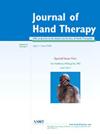关于轻度至中度腕管综合征患者在接受体外冲击波和低强度激光治疗后正中神经横截面积和疼痛变化的随机临床试验。
IF 2.1
4区 医学
Q2 ORTHOPEDICS
引用次数: 0
摘要
背景:腕管综合征(CTS)是上肢最常见的单神经病变。目的:本研究旨在比较体外冲击波疗法(ESWT)和低强度激光疗法(LLLT)与传统疗法(包括腕关节活动、经皮神经电刺激和超声波)对轻度至中度 CTS 患者正中神经横截面积(CSA)和疼痛的疗效:这是一项单盲随机临床试验,注册号为 IRCT20220504054734N1:采用区组平衡随机法将 36 名患者随机分配到 2 周内接受 10 次常规治疗的同时接受 4 次 ESWT 或 10 次 LLLT 治疗。患者会收到标明治疗组别的编号信封。完成治疗的 18 名患者的 CSA(主要)和疼痛(次要)分别在基线和 2 周后由盲人评估员进行评估。由于数据的正态分布已通过 Kolmogorov-Smirnoff 检验,因此采用配对和独立样本 t 检验进行分析。科恩效应大小(Cohen's d effect size)用于评估干预效果的大小:结果:ESWT 组和 LLLT 组的 CSA(p = 0.002)和疼痛(p 结论:ESWT 组和 LLLT 组的 CSA 和疼痛均有明显改善:在常规治疗的基础上增加 LLLT 或 ESWT,可有效减轻轻度至中度 CTS 患者的疼痛和正中神经 CSA。ESWT 和 LLLT 之间没有明显差异,这表明它们在缓解疼痛和减少 CSA 方面的疗效相当。本文章由计算机程序翻译,如有差异,请以英文原文为准。
A randomized clinical trial on the changing of median nerve cross-sectional area and pain after extracorporeal shock wave and low-level laser therapy added to conventional physical therapy in patients with mild-to-moderate carpal tunnel syndrome
Background
Carpal tunnel syndrome (CTS) is the most common mononeuropathy in the upper limb. It remains uncertain whether adding extracorporeal shockwave therapy (ESWT) or low-level laser therapy (LLLT) to conventional treatment benefits CTS patients.
Purpose
This study aimed to compare the effectiveness of ESWT and LLLT in conjunction with conventional treatments (including carpal mobilization, transcutaneous electrical nerve stimulation, and ultrasound) on the cross-sectional area (CSA) of the median nerve and pain in mild-to-moderate CTS patients.
Study Design
This was a single-blinded randomized clinical trial with registration number IRCT20220504054734N1.
Methods
Thirty-six patients were randomly assigned using block balanced randomization to receive either four sessions of ESWT or 10 sessions of LLLT in addition to 10 sessions of conventional treatments over 2 weeks. Patients received numbered closed envelopes indicating their treatment group. CSA (primary) and pain (secondary) in 18 patients who completed the treatment were assessed at baseline and after 2 weeks by a blinded assessor. Paired and independent sample t-tests were used for analyses due to the normal distribution of data was checked by Kolmogorov-Smirnoff. Cohen's d effect size was used to assess the intervention's magnitude.
Results
Both ESWT and LLLT groups showed significant improvements in CSA (p = 0.002) and pain (p < 0.001) from baseline to posttreatment. CSA improvement was moderate for ESWT (mean difference: 1.2, 95% CI 0.51-1.9) and mild for LLLT (mean difference: 0.76, 95% CI 0.4-1.14). Conversely, pain improvement was substantial in both groups (ESWT: mean difference 4.4, 95% CI 3.6-5.3; LLLT: mean difference 4.4, 95% CI 3.7-5.2). No substantial differences between ESWT and LLLT were observed, highlighting their comparable efficacy.
Conclusion
The addition of either LLLT or ESWT to conventional treatment effectively reduced pain and median nerve CSA in mild-to-moderate CTS. The absence of significant differences between ESWT and LLLT indicates their comparable efficacy in pain relief and CSA reduction.
求助全文
通过发布文献求助,成功后即可免费获取论文全文。
去求助
来源期刊

Journal of Hand Therapy
医学-外科
CiteScore
3.50
自引率
10.00%
发文量
65
审稿时长
19.2 weeks
期刊介绍:
The Journal of Hand Therapy is designed for hand therapists, occupational and physical therapists, and other hand specialists involved in the rehabilitation of disabling hand problems. The Journal functions as a source of education and information by publishing scientific and clinical articles. Regular features include original reports, clinical reviews, case studies, editorials, and book reviews.
 求助内容:
求助内容: 应助结果提醒方式:
应助结果提醒方式:


